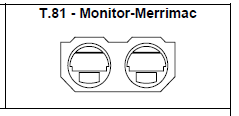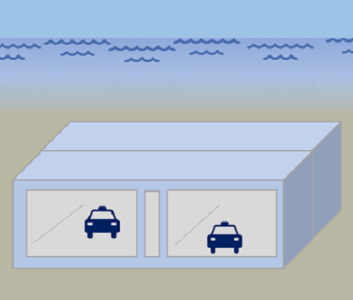Monitor-Merrimac Tunnel
HEIGHT: 12 m
WIDTH: 24 m
TOTAL IMMERSED LENGTH: 1,425 m
DEPTH AT BOTTOM OF STRUCTURE: 36 m
ENVIRONMENTAL CONDITIONS:
Very strong tidal currents around the point where the James River meets the open water
of Hampton Roads required heavy anchor lines and special precautions during
maneuvering and placement of the elements. Very active ship channel, with much
pleasure-boating.
FABRICATION METHOD:
Elements were fabricated in Baltimore at the Sparrows
Point Shipyard of Bethlehem Steel Co. The elements
were assembled in a drydock, and all interior concrete
(except walkways) was installed before closing of the
ends with bulkheads. The elements were then floated out
with approximately 7.5 m draft. An additional 2,700 m³
was added at a pier prior to towing the element to
Newport News (draft was about 10 m).
WIDTH: 24 m
TOTAL IMMERSED LENGTH: 1,425 m
DEPTH AT BOTTOM OF STRUCTURE: 36 m
ENVIRONMENTAL CONDITIONS:
Very strong tidal currents around the point where the James River meets the open water
of Hampton Roads required heavy anchor lines and special precautions during
maneuvering and placement of the elements. Very active ship channel, with much
pleasure-boating.
FABRICATION METHOD:
Elements were fabricated in Baltimore at the Sparrows
Point Shipyard of Bethlehem Steel Co. The elements
were assembled in a drydock, and all interior concrete
(except walkways) was installed before closing of the
ends with bulkheads. The elements were then floated out
with approximately 7.5 m draft. An additional 2,700 m³
was added at a pier prior to towing the element to
Newport News (draft was about 10 m).
Hampton Roads, between Newport News and Chesapeake,
United States

Virginia Department of Transportation.
Morrison Knudsen Inc, and Interbeton Inc in Joint Venture.
Sverdrup Corporation.
95m
1,425m
36m
Project construction
1992-04-30
15
Two tubes; two lanes in each tube
12m
24m
Extends between man-made peninsula and a man-made island, where it joins a trestle.
At 6 miles long, it is one of the longest subsea crossings. This is one of the few
immersed tunnel projects in the U.S. for which a drydock was used. The navigation
channel was so narrow that it had to be closed during placement of the elements.
At 6 miles long, it is one of the longest subsea crossings. This is one of the few
immersed tunnel projects in the U.S. for which a drydock was used. The navigation
channel was so narrow that it had to be closed during placement of the elements.
Elements were fabricated in Baltimore at the Sparrows
Point Shipyard of Bethlehem Steel Co. The elements
were assembled in a drydock, and all interior concrete
(except walkways) was installed before closing of the
ends with bulkheads. The elements were then floated out
with approximately 7.5 m draft. An additional 2,700 m³
was added at a pier prior to towing the element to
Newport News (draft was about 10 m).
Point Shipyard of Bethlehem Steel Co. The elements
were assembled in a drydock, and all interior concrete
(except walkways) was installed before closing of the
ends with bulkheads. The elements were then floated out
with approximately 7.5 m draft. An additional 2,700 m³
was added at a pier prior to towing the element to
Newport News (draft was about 10 m).
Interior concrete was
placed at shipyard. Final
concrete was placed at jetty
in Newport News, Va.
placed at shipyard. Final
concrete was placed at jetty
in Newport News, Va.
Very strong tidal currents around the point where the James River meets the open water
of Hampton Roads required heavy anchor lines and special precautions during
maneuvering and placement of the elements. Very active ship channel, with much
pleasure-boating.
of Hampton Roads required heavy anchor lines and special precautions during
maneuvering and placement of the elements. Very active ship channel, with much
pleasure-boating.
Remotely controlled wedges used for horizontal alignment. Conventional catamaran
barge system was used, with a laybarge consisting of two railroad car barges with
support beams between them.
barge system was used, with a laybarge consisting of two railroad car barges with
support beams between them.
Standard double gasket
and closure plate detail
used in the U.S. for many
years.
and closure plate detail
used in the U.S. for many
years.
Steel shell and liner plate.
Screeded foundation. Screed rig designed to be unaffected by tidal variations.
A 0.90 m wall was constructed on each element to
contain rock ballast. In addition, rock and armour stone
were placed on top of the element as protection.
contain rock ballast. In addition, rock and armour stone
were placed on top of the element as protection.
1.03. After dewatering, joints, 1.07 without backfill.

